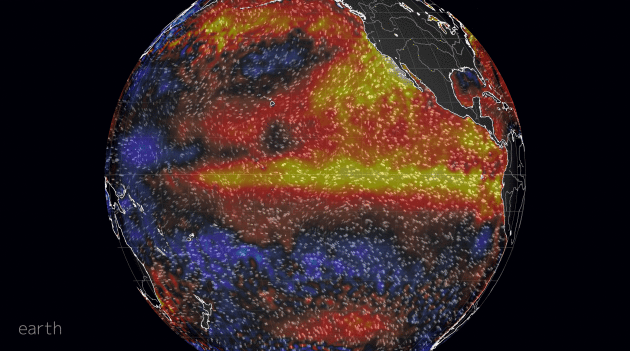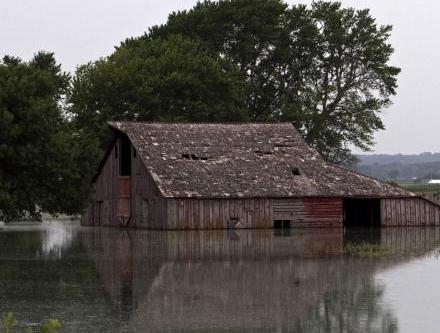72 F. high in the Twin Cities Monday.
58 F. average high for KMSP on October 17.
56 F. high temperature on October 17, 2015.
October 18,1950: Record high temperatures are set across the area as highs reached the mid to upper 80s. Minneapolis and Farmington saw highs of 87 degrees Fahrenheit, while Albert Lea reached 86 degrees.
October 18, 1916: A blizzard impacts Minnesota. A sharp temperature drop begins as well; Hallock drops from the 60s to 2 above by the 20th.
Aug-tober 18 – Our Slow Summer Simmer Continues
NASA reports last month was the warmest September on record, worldwide. Stop me if you’ve heard this before. That makes 12 straight months of “warmest on record”. I’m sure it’s all a coincidence.
Yesterday, while I was tracking a severe thunderstorm risk in the Twin Cities, meteorologists in the southern Plains saw the mercury approach 100 degrees. On the 17th day of October. With a sun angle identical to February 25.
At some point summer will fade, frost will form on the tip of your nose and “snow”, a delightful, frozen form of water, will white-wash your yard. At the rate we’re going that may happen in late November.
A west breeze dries us out today with enough sun for low 60s. Highs hold in the 50s from Thursday into much of next week; the best chance of fleeting (rain) showers Wednesday night, again Friday. ECMWF (European) guidance hints at heavier, steadier rain by the middle of next week. NOAA’s GFS model predicts low 50s for Halloween.
Not a blizzard in sight.
Wait, there are still boats in the water. In mid-October. In Minnesota. Disturbingly awesome.
3 pm Monday surface temperatures courtesy of Oklahoma Mesonet.
Minnesota and Wisconsin At Greatest Risk of Solar Storm-Related Grid Failures? Well here’s a big day-brightener. Due to a combination of factors, geomagnetic storms and magnetic material deep underground, Minnesota and Wisconsin may have the greatest potential for power outages related to solar activity, according to a story at Daily Mail Online: “Solar storms threaten Earth about every 100 years and experts warn we are overdue. Now, researchers have released the first ever map that shows which area of the US are at high risk of being hit by the next intense storm. The map was built using geomagnetic storm measurements and data from magnetic materials beneath the Earth – revealing Minnesota is particularly at risk of being blasted by solar material...”
Map credit: “Researchers created a map that shows what areas of the US are at high risk of intense solar storms. The red and black dots represent areas at the highest risk, green and yellow are the lowest and gray means there is not yet enough data to map a geoelectric hazard.”

Is La Nina Rising From the Dead? It would appear that way; NOAA has reissued a La Nina Watch for the winter months as Pacific Ocean waters cool. Odds are it will wind up being a minor/weak La Nina. Here’s an excerpt from Discover: “A month ago, forecasters were writing the obituary for La Niña. Still in gestation at the time, it looked like it was going to be stillborn. Not any longer. The latest forecast from the Climate Prediction Center pegs the odds of La Niña coming to term at 70 percent during fall in the Northern Hemisphere. When a La Niña does develop, it has impacts on temperature and precipitation around the world. For a summary of what typically happens, click on the graphic at right. And for more detail on typical U.S. impacts, check out this explainer on Climate.gov...”
Animation credit: “The two images in this animation show the evolution of sea surface temperatures in the equatorial Pacific Ocean. The first image shows a spear of abnormally warm water along the equator on Oct. 12, 2015 indicative of El Niño conditions. The second image, from exactly one year later, shows the dramatic cooling of a possible La Niña.” (Source: earth.nullschool.net).
More June Than October. Here are derived Doppler radar rainfall amounts from last night’s heavy thunderstorms; 1-2″ falling over the south metro (with very little rain reported over the northwest suburbs as of 10:30pm.
Slight Cooling Trend. Nothing controversial brewing, but temperatures do cool back down to average by Thursday and Friday; highs mainly in the 50s into next week. I still don’t see an (official) first frost for KMSP (Twin Cities International Airport) through next week, meaning the growing season for the downtowns will wind up well over a month longer than average. EMCWF (European) numbers: WeatherBell.
A Break From Monsoon Season? No promises, but the most significant storms are forecast to buffet the Ohio Valley, New England and Pacific Northwest over the next week. Light showers are possible here Wednesday night, again on Friday, but these will be fast-moving clipper-like systems, moving too fast to tap moisture from the Gulf of Mexico. WPC 7-Day rainfall: NOAA and WeatherBell.

Why Isn’t The U.S. Better At Predicting Extreme Weather? The New York Times takes a look at a question that comes up fairly frequently; here’s an excerpt: “…As Mass points out, accuracy is everything, often the difference between life and death, given that extreme weather — tornadoes, flash floods, heat waves — kills more than 500 Americans each year. “An incremental improvement would make a huge difference,” he says. Industries like shipping, energy, agriculture and utilities lose money when predictions fail. Even slightly more precise wind-speed projections would help airlines greatly reduce fuel costs. Mass participates regularly on government committees tasked with improving forecasts, where his message is consistently the same — in his words, “We could be doing much better, and it’s outrageous that we’re not.” Last year, he notes, the Air Force began paying Britain’s Met Office $100,000 a year to license its weather-modeling software. “That a U.S. government agency has decided that our capability is not good enough is pretty amazing,” he says…”
North Carolina Buildings Take $1.5 Billion Hit From Matthew Floods. Here’s an excerpt from AP: “Flooding spawned by Hurricane Matthew has caused $1.5 billion in damage to 100,000 homes, businesses and government buildings in North Carolina, according to a state estimate. The figure released late Saturday represents one of the first detailed analyses of damage from the storm, and it’s part of a growing picture of Matthew’s financial impact. With floodwaters yet to recede in some communities, officials say the number could fluctuate. “I do think that there may be more out there,” John Dorman, an assistant state emergency management director, said of whether the number could grow…”
Image credit: Capital Weather Gang, which has more astonishing, heartbreaking imagery from the thousand-year flood that hit North Carolina.
Sea Level Rise Upping Ante on “Sunny Day” Floods. Climate Central reports; here’s an excerpt that caught my eye: “…While flooding from king tides, and similar floods from storms or high winds, aren’t usually as severe as the ones doled out by hurricanes and tropical storms, they happen much more frequently. Recent research attributes about 6 inches of the world’s sea level rise that has occurred since 1900 to human-caused global warming. And given current levels of carbon emissions, that rate is expected to accelerate. Scientists project that sea level rise could surpass 3 feet by the end of the century. At the local level, sea level rise amounts to higher water lines during high tides, so local thresholds for minor floods are surpassed more frequently now than in the past. The States at Risk program has investigated how many of these sunny day floods can be attributed to human-caused climate change — in other words, how many more flood days we have created because of the higher water levels from sea level rise...”
Global Sea Levels Are Rising Fast. So Where Does That Leave the Cities Most At Risk? Cities in southeast Asia are even more vulnerable than U.S. coastal cities. The Guardian reports: “…Lewis says the best option for many flood-risk cities looking to take action is to develop independent partnerships and networks to learn from each other – adding that this is the “cheapest and most effective way of doing work”. For example, the Netherlands embassy in Washington DC consults and collaborates with a number of vulnerable US cities, including Norfolk, Virginia, and New Orleans, Louisiana. According to Dale Morris, a senior economist at the embassy, some of the shared ideas follow the principle of adapting to living with water, not keeping it out. (About a third of the Netherlands is below sea level, with another third presently at sea level.)...
Map credit: “The 20 world cities with the highest number of people at risk from flooding, accounting for future climate and socioeconomic change.” Source: OECD
How The Western Water Wars May End. The Christian Science Monitor reports: “…The pressure to solve decades-old disputes is rising. Water is already one of the West’s most contentious issues, with an infinite number of colliding interests – urban residents, farmers, environmentalists, native Americans, agribusiness owners, hydroelectric operators – all dipping their hoses into receding rivers and reservoirs. The only thing they all seem to have in common is their impulse to hire a lawyer. Now, amid growing urbanization and the effects of climate change, the tensions are becoming even more fraught. Yet the Yakima accord has given some people optimism that there’s a way out of this Gordian knot. They hope the example here – the deal as well as the years of squabbling and millions of dollars spent in courtrooms – will convince other regions to broker similar accords rather than perpetuate the debilitating era of water wars…” (Image: NOAA).
Cargill’s Food Empire Adapts to a Changing World. Minnesota-based Cargill’s CEO was recently featured in a Wall Street Journal interview; here’s an excerpt that caught my eye:
WSJ: How do you see climate change affecting food production and what you’re doing at Cargill?
MR. MACLENNAN: Climate change is here, and it’s going to change how and where food is grown. Today, the U.S. corn belt is in Iowa, Illinois, Indiana. In 50 years, it may be in Hudson Bay, Canada. What does that mean for supply-chain companies and food production, and trying to get in front of it? How farmers grow the food, where they grow it, the need for analytical tools to help them respond to periods of great weather or horrible weather—that’s where Cargill can play a role...”
How Agriculture Can Reduce Greenhouse Gas Emissions. Here’s another excerpt from a timely Wall Street Journal story: “…While changing eating habits is notoriously difficult, there are other steps we can take to reduce agriculture emissions. For example, by changing farming practices through different crop management approaches, improved fertilizer management, conservation tillage, and better management of grazing lands. The U.S. Department of Agriculture recently released a set of 10 building blocks, from soil health to nutrient management, to reduce agriculture emissions. Existing technologies and best practices could reduce agriculture emissions by around 20% to 40%, a team of researchers recently found. But more transformative technologies and practices will be needed to reduce emissions further to achieve the ambitious long-term reduction goals agreed upon in Paris…”
File photo credit: “WSJ Energy Expert says that while changing eating habits is important, changing agricultural practices will have a much bigger impact on carbon emissions.” Photo: iStock Photo.
Flow Batteries: A New Kind of Energy Storage. A promising new technology is explained at Yale Climate Connections: “…But with renewable power sources, things get more complex. The sun cannot shine brighter just because everyone turns on their air conditioners. So finding a way to store energy that we can use as needed is a priority. Gyuk believes a new type of flow battery is one promising method. Flow batteries can handle fluctuating amounts of energy better than traditional lithium ion batteries. They’re currently more expensive, but flow batteries are getting cheaper to make, and people are starting to use them as a powerful and cost-effective storage solution. Several states have already incorporated flow batteries into local energy grids. Gyuk: “Ultimately, using storage means that more renewable energy can be accommodated on the grid…”
NFL Ratings Plunge Could Spell Doom for Traditional TV. Because we’re increasingly addicted to our smart phones, according to The Washington Post: “…Network executives have long used the National Football League’s live games as a last line of defense against the rapid growth of “cord-cutting” and on-demand viewing upending the industry. But now, the NFL is seeing its ratings tumble in the same way that the Olympics, awards shows and other live events have, falling more than 10 percent for the first five weeks of the season compared with the first five weeks of last season. A continued slide, executives say, could pose an even bigger danger: If football can’t survive the new age of TV, what can?…”
Photo credit: “New England Patriots quarterback Tom Brady fakes a hand off during an NFL football game against the Cleveland Browns, Sunday, Oct. 9, 2016, in Cleveland. New England won 33-13.” (David Richard/AP).
What If The Newspaper Industry Made a Colossal Mistake? Politico Magazine has food for thought: “…Buttressed by copious mounds of data and a rigorous, sustained argument, the paper cracks open the watchworks of the newspaper industry to make a convincing case that the tech-heavy Web strategy pursued by most papers has been a bust. The key to the newspaper future might reside in its past and not in smartphones, iPads and VR. “Digital first,” the authors claim, has been a losing proposition for most newspapers. These findings matter because conventional newspapers, for all their shortcomings, remain the best source of information about the workings of our government, of industry, and of the major institutions that dominate our lives. They still publish a disproportionate amount of the accountability journalism available, a function that’s not being fully replaced by online newcomers or the nonprofit entities that have popped up…” (Image credit here).
Y’all, You’uns, Yinz, Youse: How Regional Dialects Are Fixing Standard English. Because, in the English language, there is no effective way to refer to “you” (plural!) Here’s an excerpt at Atlas Obscura: “…In “standard American English,” meaning, essentially, schoolroom English, the second person pronoun is “you,” for either singular or plural. Talking to your spouse? Use “you.” Talking to your spouse and his or her entire family, at the same time? Use…well, also use “you.” It is a huge, strange weakness in American English: when someone is talking to a group of people, we have no way of indicating whether the speaker is talking to only one person or the entire group. Peeking your head out from the kitchen at a dinner party and asking, “Hey, can you get me a drink?” is likely to score you a look of confusion. Who are you talking to, exactly?…”

TODAY: Clearing and pleasant. Winds: W 8-13. High: 63
TUESDAY NIGHT: Partly cloudy. Low: 47
WEDNESDAY: Clouds increase, shower at night. Winds: NW 7-12. High: near 60
THURSDAY: Damp start, mostly cloudy and cool. Winds: NW 7-12. Wake-up: 42. High: 51
FRIDAY: Unsettled, few PM showers. Winds: SE 5-10. Wake-up: 38. High: 53
SATURDAY: Mix of clouds and sun. Not bad. Winds: NW 8-13. Wake-up: 39. High: 58
SUNDAY: Partly sunny and breezy. Winds: SE 8-13. Wake-up: 46. High: near 60
MONDAY: Peeks of sun, still pretty quiet. Winds: E 5-10. Wake-up: 45. High: 58
Climate Stories….

MAP BY FAO.
Banning the “Super” Greenhouse Gas. Deutsche Welle has more on the banning of HFC’s: “…HFCs are catastrophic for global warming. Scientists later realized that HFCs – which don’t harm the now-healing ozone layer – are thousands of times more potent at trapping heat in the atmosphere than carbon dioxide, the most abundant greenhouse gas. US Secretary of State John Kerry, who attended last week’s meeting in Rwanda, said recently that each year, HFCs currently emit as much pollution as 300 coal-fired power plants. And what makes HFCs even more worrying is that they are increasing at a rate of 10 to 15 percent a year, according to Greenpeace, which it says makes them the fastest-growing greenhouse gas. This growth is mainly due to demand for air conditioners – according to the Berkeley National Laboratory, the world is likely to have another 700 million air conditioners by 2030…”
The Kigali Deal on HFCs Is Important, But Won’t Save Us Another Half Degree. More perspective from Climate Interactive.

